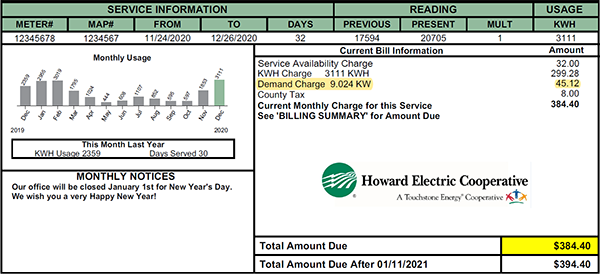Five years ago, Howard Electric Cooperative faced the possibility of plummeting revenues as consumer-members began installing more and more solar panels on their homes, reducing demand for electricity from the co-op.
[section separator="true"]
[section-item 6]
[row]
[column 12]
CEO Richard Fowler knew the most obvious solution was to raise rates, but he feared that would do more harm than good.
“This vicious cycle of adding solar and raising the availability charge or the kWh rate will eventually hurt our poorer members—and all members—and the smaller co-ops will feel it first and be hit the hardest," says Fowler, who has led the co-op for 30 years.
[/column]
[/row]
[/section-item]
[section-item 6]
[row]
[column 12]
[image-caption title="Howard%20Electric%20Cooperative%20CEO%20Richard%20Fowler" description="%20" image="%2Fremagazine%2Farticles%2FPublishingImages%2FRichard-Fowler-Howard%20EC.jpg" /]
[/column]
[/row]
[/section-item]
[/section]
Plus, he adds, “If you're like my co-op, you've got a lot of barns, shops and small users who would simply disconnect with a higher availability charge, and now you've got even more lost revenues."
Instead, in 2016, Howard EC became the third electric co-op in the nation to implement demand rates for all residential members.
The 3,600-member co-op based in Fayette, Missouri, still charges a basic rate using kilowatt-hours. But it also adds a charge that is measured during morning and evening peak hours and based on a member's highest kilowatt usage during those times. Modern meter technology makes it possible to keep track of demand down to the quarter-hour.
[blockquote quote="A%20member%20whose%20peak%20demand%20is%20low%20shouldn't%20have%20to%20subsidize%20people%20whose%20peak%20demand%20is%20high." author="Richard%20Fowler%2C%20CEO%2C%20Howard%20Electric%20Cooperative" /]
Members with solar panels are still adding to the co-op's peak demand by tapping into the grid when the sun goes down. A demand charge ensures that everyone is paying their fair share and that consumers whose peak power usage is low are not penalized, Fowler says.
“This was fundamentally about fairness," he says. “And it's not just about solar. Some members have electric instantaneous water heaters, hot tubs and other appliances that also add to peak demand. A member whose peak demand is low shouldn't have to subsidize people whose peak demand is high."
Members' reaction to the demand charge has been a “nonevent," Fowler says. He attributes that to a slow phase-in and a strong training program for co-op employees who respond to member questions.

The demand rate rose gradually over five years, starting at 75 cents a kilowatt and increasing a little each year to the current $5, says Amber Overfelt, the co-op's assistant manager.
“We got a lot of phone calls at the beginning," she says. “It gave us a chance to have a conversation with our members. They really responded to the fairness aspect. They agreed that an elderly neighbor who uses little electricity should not have to subsidize people with lots of appliances."
Today, those phone calls from members asking about the demand charge are “few and far between," she says.
Still, co-op employees continue to work with members to lower their peak demand. And a detailed explanation of how demand charges work remains on the co-op's website.
“The education with our members will be an ongoing process," Fowler says.
[image-caption title="Howard%20EC's%20AMI%20system%20allowed%20the%20co-op%20to%20implement%20a%20demand%20rate%20program." description="%20" image="%2Fremagazine%2Farticles%2FPublishingImages%2FDustin-installing-meter-Howard-EC.jpg" /]
As the demand charge increased over five years, the kilowatt-hour charge was reduced, making the initiative essentially revenue neutral. Roughly one-third of members have seen a rate decrease, one-third an increase and one-third little or no change.
“To protect electric cooperatives' revenue base, demand rates are going to become a trend among electric co-ops," predicts Fowler, who spent five years working for the Arkansas Public Service Commission and testified in 33 rate cases before going to work for his first co-op. “Since we installed demand rates, several other Missouri co-ops have done the same or are planning to do so. I've talked to co-op groups in seven states that are interested. I believe this is the solution for co-ops big and small."
Questions about demand rates? Contact Fowler at rfowler@howardelectric.com.
